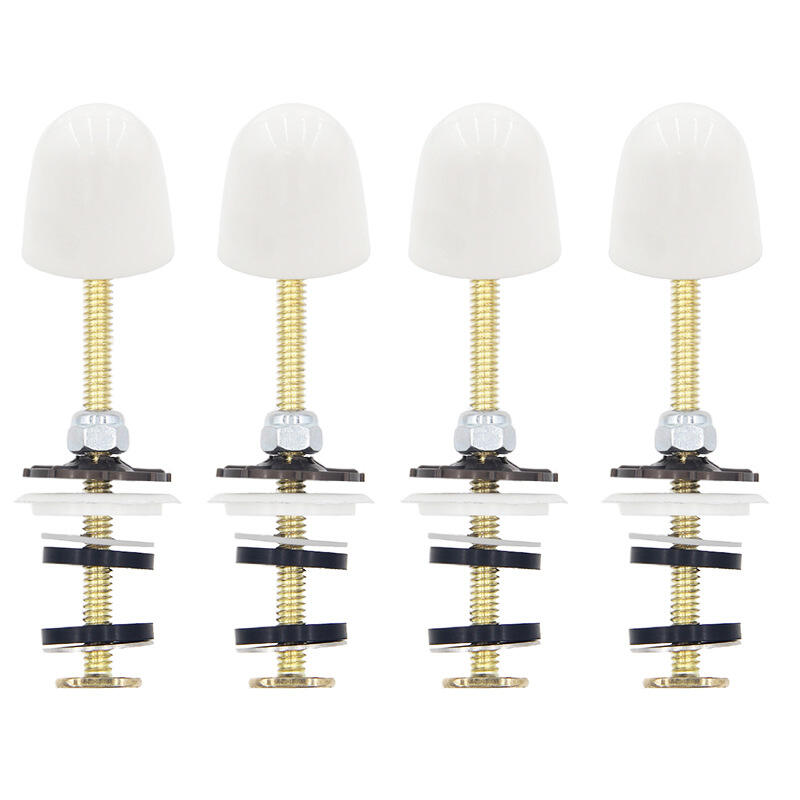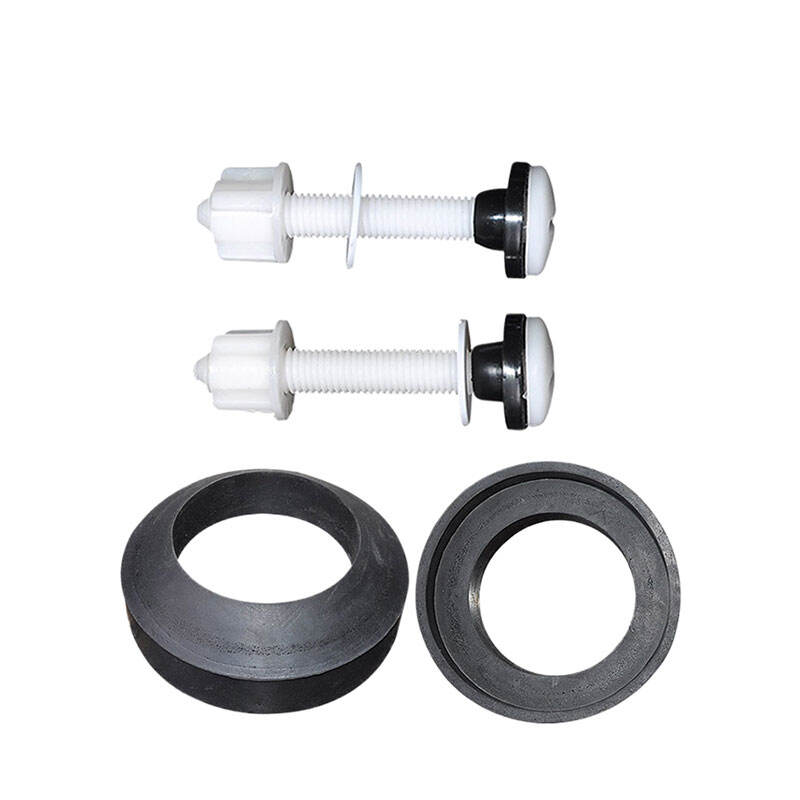Understanding Toilet Bolts: Function, Materials, and Importance in Installation
The role of toilet bolts in securing the tank and bowl to prevent movement
The bolts on a toilet are really important because they hold the tank firmly against the bowl and keep everything attached to the floor flange properly. These little metal pieces actually take on all the sideways force when someone sits down or flushes regularly. Without them doing their job right, the whole thing might start moving around which puts stress on those delicate porcelain connections and eventually breaks the seal. When the bolts are snug, they spread out the pressure evenly over the wax ring and rubber gasket underneath. But if they're left loose, even tiny movements happen every time the toilet is used, and this gradual shifting wears away at the sealing surfaces until water starts leaking through.
How incorrect or damaged toilet bolts cause leaks, cracks, and misalignment
According to recent studies in the plumbing field, about 38 percent of all toilet leaks actually come down to problems with those little tank bolts (National Association of Home Builders reported this back in 2023). When these bolts get corroded or don't match properly, they tend to compress unevenly around the tank, letting water sneak past the seals where it shouldn't be going. Another big problem people run into? Over tightening them, particularly when working with tougher materials such as stainless steel bolts. This can crack the porcelain tank itself, which means expensive fixes that typically cost around four hundred twenty dollars on average. Anyone looking to avoid these headaches should definitely take some time to read through proper installation instructions before swapping out any old parts. A few extra minutes spent reading those guidelines could save a lot of money and frustration later on.
Common materials used in toilet bolt construction: Brass, stainless steel, and plastic-coated options
- Brass: Offers good strength and moderate corrosion resistance but is susceptible to dezincification in acidic water conditions
- Stainless steel: Provides superior rust protection, ideal for humid environments; however, its hardness increases the risk of porcelain cracking if overtorqued
- Plastic-coated steel: Cost effective and prevents galvanic corrosion, though the polymer coating may degrade under chemical exposure
Stainless steel now accounts for 61% of new installations, reflecting a growing preference for durability in modern bathrooms.
Standard Toilet Bolt Sizes and How to Measure for the Right Fit
Typical Bolt Length and Diameter for Residential Toilets
The majority of home toilets need bolts that are about a quarter inch thick and somewhere between 2.5 to 3 inches long when connecting the tank to the bowl itself. This sizing works well with typical porcelain thicknesses ranging from three quarters of an inch up to just over an inch and a quarter, plus leaves enough room for those nylon locking nuts to grip properly. When it comes time to install floor flanges though, plumbers generally go with 5/16 inch diameter bolts instead. Why? Because these stronger bolts can handle more stress and support much heavier toilet models, including special ones designed for accessibility requirements that can weigh as much as 300 pounds or so. Makes sense really, since nobody wants their bathroom fixture coming loose after installation!
| Component | Diameter | Length | Material |
|---|---|---|---|
| Tank-to-Bowl Bolts | 1/4 inch | 2.5—3 inches | Brass/Stainless |
| Floor Flange Bolts | 5/16 inch | 1.5—2 inches | Stainless Steel |
Measuring Bolt Spread: Center to Center Distance Between Toilet Bolt Holes
The standard bolt spread—the center-to-center distance between floor flange bolt holes—is 5.5 inches across most North American installations. Use a ruler or caliper to measure accurately. For tank bolts, the vertical spacing between mounting holes typically ranges from 4 to 6 inches, depending on the tank design.
Universal Standards vs. Manufacturer-Specific Variations
The standard flange bolt spacing tends to be around 5.5 inches, though some companies go their own way with different specs. Kohler goes smaller at 5.25 inches while Toto actually needs a bit more room at 5.75 inches. And don't forget about those older American Standard toilets either they often need something closer to 5.125 inches. Most plumbers stock universal brass bolts since these work for about 95% of jobs. But watch out for European made fixtures where plastic coated bolts become necessary instead. This helps prevent that nasty problem called galvanic corrosion when metals react badly together over time.
Matching Tank to Bowl and Floor Flange Bolts for a Secure, Leak-Free Seal
Selecting Proper Tank to Bowl Bolts Based on Porcelain Thickness and Alignment
Picking the right bolts makes all the difference when it comes to keeping things stable and avoiding damage to porcelain surfaces. Most home installations get by fine with standard quarter inch bolts that are around 2.5 to 3 inches long. However, if dealing with heavier duty porcelain found in commercial settings, going up to 3.5 inch bolts often provides better grip since they engage more threads. When bolts aren't properly aligned, they create unnecessary pressure points on the ceramic material, which can result in those annoying hairline cracks nobody wants to see. The folks at National Plumbing Foundation reported back in 2023 that fixing these kinds of leaks typically costs anywhere between four hundred bucks and twelve hundred dollars depending on how bad the damage gets. A good rule of thumb? Tighten each bolt gradually with a nut driver, working your way around the tank in small steps until everything feels secure without overdoing it.
Replacing Corroded or Broken Bolts: Compatibility and Upgrade Considerations
When dealing with old plumbing fixtures, it's wise to swap out those rusty brass or steel bolts for something better suited to fight corrosion. Stainless steel options work great, but don't forget about nylon coated varieties either since they stand up well against mineral deposits over time. Now if we're talking about toilets made prior to 2010, there's an important detail worth checking first. These older models usually follow different threading specs, specifically around 20 threads per inch according to ANSI standards. Most contemporary replacement kits come equipped with handy plastic adapters that fit nicely into different porcelain thicknesses across various toilet models. And here's another tip worth remembering: switching to bolts featuring neoprene washers makes all the difference in maintaining a good seal over years of use. Unlike regular rubber gaskets which tend to wear unevenly, these neoprene versions distribute pressure much more consistently, keeping leaks at bay for longer periods between maintenance checks.
How Toilet Flange Alignment Impacts Bolt Placement and Floor Stability
When a flange isn't properly aligned, it can push bolts sideways which makes the toilet bowl unstable and breaks the wax seal that keeps everything watertight. The bolts need to sit about 1/8 inch from the center line of the flange to seat correctly. For those tricky installations on sloped or uneven floors, adjustable stainless steel extenders or offset rings work wonders to get things back in line. Always do a dry fit first before putting on the wax ring. If the toilet wobbles or needs a lot of muscle to snap into place, time to adjust those bolts again. Pretty shocking actually, but according to Plumbing Manufacturers International data from 2023, around 43 percent of all leaks after installation happen because of this kind of alignment issue in DIY plumbing jobs.
Top Mount vs Bottom Mount Toilet Bolts: Installation and Design Trade offs
Design and Functional Differences Between Top Mount and Bottom Mount Systems
The top mount bolts go right through the bottom of the tank and into those threaded holes in the bowl below. What this means is that all those screws stick out above the porcelain surface where anyone can see them. Makes sense if someone needs to tweak things later on, but honestly looks pretty basic and functional. With bottom mount systems though, everything works differently. The bolts start at the bowl itself and work their way up into the tank instead, so none of those metal parts show through the porcelain finish. A much neater appearance overall. Most folks will find that top mounts tend to be made from either brass or stainless steel materials. Bottom mounts usually come with plastic coatings on the shafts though. Manufacturers do this to prevent scratching the porcelain when they install them. Just another small detail that matters when putting these fixtures together.
Ease of Installation, Durability, and Long Term Maintenance Comparison
Installation times for top mount systems are generally around 15 to 25 percent quicker because mechanics just need to reach down from above to snug everything up without taking apart components first. With bottom mounts though, getting those bolts aligned properly in the cramped area underneath tanks is a real challenge and often leads to mistakes during assembly. Testing has revealed that stainless steel bolts used in top mounts can handle about 300 to 400 pound inches of torque force, which actually gives them roughly 30 percent extra strength compared to their bottom mounted counterparts thanks to less sideways pressure on the fasteners. On the flip side, bottom mounted hardware tends to protect thread surfaces better against mineral deposits that build up over time, so these systems typically need maintenance work maybe 40% less frequently than top mounts would after ten years or so in service.
Growing Trend Toward Concealed Bottom Mount Bolts in Modern Toilet Designs
Seventy-eight percent of toilets hitting stores in 2023 came with hidden fastening systems, showing just how much people want those clean, modern looks these days. The manufacturers aren't sitting still either, coming out with ready-made bolt packages and nylon locking nuts that stop folks from tightening things too much. Retrofitting older models usually means messing with the flange, which can be a pain, but most new installs go this route now. A third of plumbers say their customers keep asking for those invisible bolts when they're redoing bathrooms to match today's style trends.




